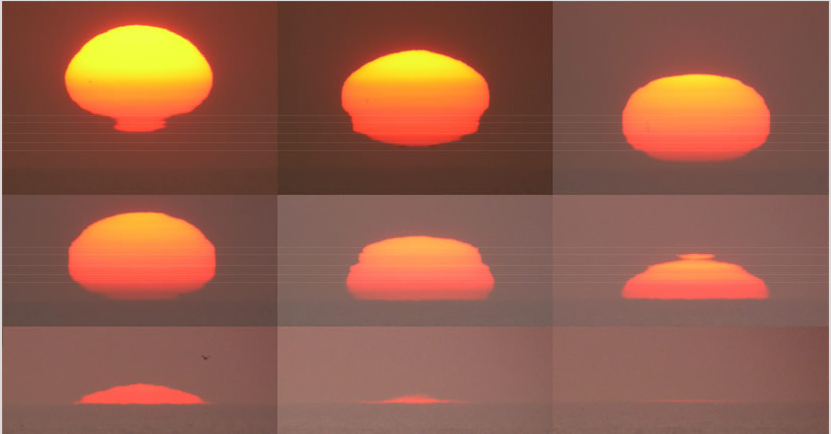Mock mirage, M-Mir, sunsets
Mock Mirage, M-Mir, and the Enchanting Sunsets
When we gaze at a setting sun and witness its distortion, seemingly cut into horizontal slices, we are witnessing the captivating phenomenon of a mock mirage sunset. This peculiar sight is an indication that one or more temperature inversion layers are at play in the atmosphere. These layers, often made visible by the dust and aerosol they trap, create greater refraction, leading to the mesmerizing display before our eyes.
As sunlight passes through the different density layers, it is refracted, sometimes with such strength that it produces mock-mirages or ray paths. The allure of these mirages is most apparent when we closely observe the sinking sun's progress. However, it is essential to exercise caution and care for our eyes during this observation. A single mock-mirage sunset typically consists of two erect images and one inverted image. Sections of the sun can be observed sinking and rising within these layers, offering glimpses of both the descending and ascending solar disk.
In certain instances, the temperature and density differences between the layers are so significant that rays become trapped within them. This phenomenon is known as ducting, where the trapped rays may travel considerable distances before finally escaping. These ducted M-Mir sunsets create an even more surreal and otherworldly spectacle.
The appearance of mock-mirage sunsets is highly dependent on our vantage point. To fully appreciate these atmospheric marvels, we must position ourselves above the inversion layer. Surprisingly, being physically very high is not a prerequisite, as inversions can occur close to the land or sea surface. Therefore, even moderate heights can provide an optimal viewpoint for experiencing the enchantment of a mock-mirage sunset.
One remarkable aspect of mock-mirage sunsets is that they occasionally produce flashes of green and blue at their zenith. While these flashes are less pronounced than the classical I-Mir flash, they are often captured through photography rather than observed directly with the naked eye. The rarity of these phenomena adds to their allure, leaving us captivated by the ever-changing colors and shapes that dance across the sky.
In order to fully grasp the intricacies and beauty of mock-mirage sunsets, it is essential to consider the various elements at play. By understanding the science behind these atmospheric optics phenomena, we can better appreciate the wonders of nature and the awe-inspiring displays that grace our skies.
Please note that this article has been automatically converted from the old site and may not appear exactly as intended.

Sunset at Pointe de la Torche , France imaged by Laurent Laveder (PhotoAstronomique.net) in August '04. The faint lines have been added to indicate layers of different temperature in the atmosphere. As the sun's image sinks through them it is miraged into fantastical ever changing shapes. The slices show descending erect images of the solar disk and ascending inverted images. Images ©Laurent Laveder, shown with permission.
A setting sun distorted and seemingly cut into horizontal slices is a sign that one or more temperature inversion layers are at work. The layers are sometimes made visible (1,2) by the dust and aerosol they trap and greater refraction.
Sunlight is refracted by the different density layers sometimes sufficiently strongly to produce mock-mirages (ray paths). The mirages are most apparent when the progress of the sinking sun is closely watched (eye care!). A single mock-mirage has two erect images and an inverted image. Sections of the sun will often be seen sinking and rising in the layers. Where an image is rising, we are seeing a section of an inverted solar disk.
Sometimes the temperature, and thus density, differences are so great that rays are trapped within layers. Ducting is said to occur and the trapped rays might travel large distances before escaping. Here are two ducted M-Mir sunsets 1,2.
Mock-mirage sunsets are very sensitive in their appearance to your height. You must be above the inversion layer but not necessarily physically very high because inversions can be very close the the land or sea surface. Two views of the same sunset are here 1,2.
The top of a mock-mirage sunset sometimes produces a single or even multiple green and blue flashes. These are less pronounced than the classical I-Mir flash and are more often photographed than observed by eye.
Note: this article has been automatically converted from the old site and may not appear as intended. You can find the original article here.
Reference Atmospheric Optics
If you use any of the definitions, information, or data presented on Atmospheric Optics, please copy the link or reference below to properly credit us as the reference source. Thank you!
-
<a href="https://atoptics.co.uk/blog/mock-mirage-m-mir-sunsets/">Mock mirage, M-Mir, sunsets </a>
-
"Mock mirage, M-Mir, sunsets ". Atmospheric Optics. Accessed on December 22, 2024. https://atoptics.co.uk/blog/mock-mirage-m-mir-sunsets/.
-
"Mock mirage, M-Mir, sunsets ". Atmospheric Optics, https://atoptics.co.uk/blog/mock-mirage-m-mir-sunsets/. Accessed 22 December, 2024
-
Mock mirage, M-Mir, sunsets . Atmospheric Optics. Retrieved from https://atoptics.co.uk/blog/mock-mirage-m-mir-sunsets/.